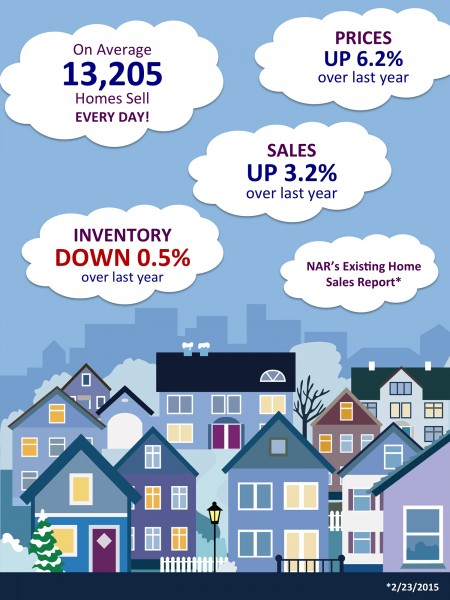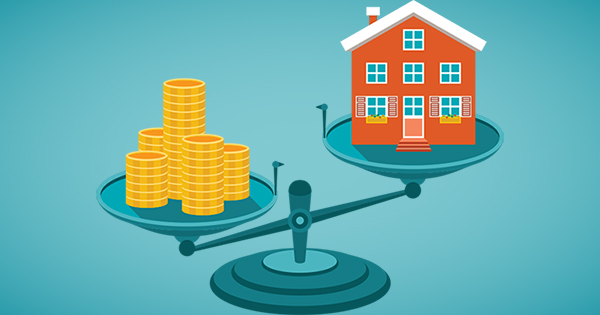
Two Graphs that Scream – List Your Home Today!

We all learned in school that when selling anything, you will get the most money if the demand for that item is high and the inventory of that item is low. It is the well-known Theory of Supply & Demand.
If you are thinking of selling your home, here are two graphs that strongly suggest that the time is now. Here is why…
DEMAND
According to research at the National Association of Realtors (NAR), buyer activity last month (January) was three times greater than it was last January. Purchasers who are ready, willing and able to buy are in the market at great numbers.
SUPPLY
The most recent Existing Home Sales Report from NAR revealed that the months’ supply of housing inventory had fallen to 4.4 months which is the lowest it has been in over a year.
Bottom Line
Listing your house for sale when demand is high and supply is low will guarantee the offers made will truly reflect the true value of your property. If you or someone you care about is interested in getting a better understanding of today’s market and where it stands, please don’t hesitate to contact me.
As I enter my 26th year in real estate, please know I stand ready and highly capable to help you and your referrals.
2015: A Year of Housing Opportunity

Many believed that when the housing market crashed, so too would the desire of American’s to own a home again. Many reports have shown that, especially among younger generations, the American Dream of homeownership is still very much alive.
Julián Castro, Secretary for HUD, recently summed up what it means to own a home in a speech at the National Press Club.
“Homeownership is still the cornerstone of the American Dream — a fact you can see in the lives of everyday folks.
It’s a source of pride. It’s a source of wealth, providing both a nest and a nest egg. And it strengthens communities and fuels growth in the overall economy.”
Castro appropriately named his speech, “2015: A Year of Housing Opportunity”, a theme that rang true throughout.
“Opportunity is not an abstract concept – it’s a path to a more prosperous life, and housing often serves as its foundation. T.S. Elliot once said that “home is where one starts from.”
“A home is often a primary source of wealth in a family… Having a home is generational way to pass that wealth on. We want people responsible enough to own a home to have that opportunity.”
Bottom Line
“Over the years-through decades of economic downturns and wars-the American people have always held on to this Dream, and always will.”
As the economy continues to improve, more and more Americans will qualify for homeownership, allowing more families to obtain the American Dream.
Foreclosure Inventory Down 34.3% from Last Year

According to the latest CoreLogic National Foreclosure Report, “approximately 552,000 homes in the US were in some state of foreclosure as of December 2014”. This figure is down 34.3% from the 840,000 homes in December of 2013. December marked the 38th consecutive month in which there were year-over-year declines.
Anand Nallathambl, the President and CEO of CoreLogic, is hopeful for the future, saying:
“At current foreclosure rates, we expect to see the foreclosure inventory in the U.S. drop below 500,000 homes sometime in the first quarter of 2015 which would be another milestone in the healing of the housing market.”
The map below shows the percentage of foreclosure inventory in each of the 50 states and Washington, D.C. Thirty-six states have inventory below the national rate of 1.4% and can be seen in two shades of green.
Bottom Line
Even though some states have not recovered completely from the foreclosure crisis, the nation as a whole is on the right track as inventory decreases.
Real Estate in Redmond Heading in the “Right Direction”

The housing market has taken a great turn toward recovery over the last few years. The opinions of the American public toward real estate took longer to recover, until recently.
For the first time since 2006, Americans have an overall positive view of real estate, giving the industry a 12% positive ranking in a Gallup poll.
Americans were asked to rate 24 different business sectors and industries on a five-point scale ranging from “very positive” to “very negative.” The poll was first conducted in 2001, and has been used as an indicator of “Americans’ overall attitudes toward each industry”.
Americans’ view of the real estate industry worsened from 2003 to the -40% plummet of 2008. Gallup offers some insight into the reason for decline:
Prices Dropped
“In late 2006, real estate prices in the U.S. began falling rapidly, and continued to drop. Many homeowners saw their home values plummet, likely contributing to real estate’s image taking a hard hit.”
Housing Bubble
“The large drops in the positive images of banking and real estate in 2008 and 2009 reflect both industries’ close ties to the recession, which was precipitated in large part because of the mortgage-related housing bubble.”
Bottom Line
“Although the image of real estate remains below the average of 24 industries Gallup has tracked, the sharp recovery from previous extreme low points suggests it is heading in the right direction.”
If the news of recovery has you considering homeownership, it would be my pleasure to meet with you to discuss the opportunities that exist in today’s market.
The Difference Between A Home’s Cost vs. Price

As a seller, you will be most concerned about ‘short term price’ – where home values are headed over the next six months. As either a first time or repeat buyer, you must not be concerned only about price but also about the ‘long term cost’ of the home.
Let us explain.
There are many factors that influence the ‘cost’ of a home. Two of the major ones are the home’s appreciation over time, and the interest rate at which a buyer can borrow the funds necessary to purchase their home. The rate at which these two factors can change is often referred to as “The Cost of Waiting”.
What will happen in 2015?
A nationwide panel of over one hundred economists, real estate experts and investment & market strategists project that home values will appreciate by almost 4% by the end of 2015.
Additionally, Freddie Mac’s most recent Economic Commentary & Projections Table predicts that the 30-year fixed mortgage rate will appreciate to 4.5% by the end of 2015.
What Does This Mean to a Buyer?
Here is a simple demonstration of what impact these projected changes would have on the mortgage payment of a home selling for approximately $250,000 today:






















